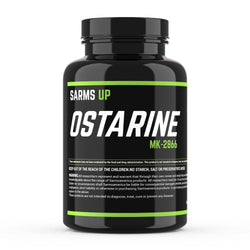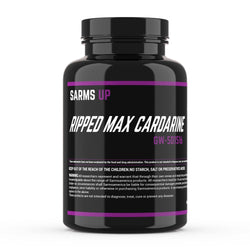Essential Guide to Building Endurance and Stamina for Peak Performance

Hit a wall when pushing your limits? Feel tired faster than you want? Building real endurance and stamina changes everything. This guide cuts through the noise, giving you the exact methods pros use to build serious staying power. Stop guessing and start performing.
Here’s what you'll discover:
-
What endurance and stamina actually are.
-
Secrets to boosting both effectively.
-
Top exercises for serious gains.
-
How Ostarine & Cardarine can help.
Need top-quality SARMs to support your endurance and stamina? SARMS UP is known for the highest purity ingredients. We make sure you get the best.
What Are Endurance and Stamina?
Endurance means your body’s ability to keep doing a lower intensity activity for a long period. Think of a marathon runner holding a steady pace or a cyclist on a long ride. It measures how long you can resist fatigue when the effort level stays fairly constant. It’s about your heart, lungs, and muscles working efficiently together over time.
Stamina is a bit different. This is your capacity to maintain maximum physical or mental effort for an extended period, even when tired. It requires not just cardiovascular fitness but also significant muscular endurance and serious mental fortitude. Pushing through that final set of burpees or staying focused during a grueling event? That’s stamina at work.
Stamina relates to fitness by being essential for achieving various fitness goals. Improving fitness stamina is crucial for endurance and strength training, allowing individuals to exert themselves more effectively during workouts.
|
Feature |
Endurance |
Stamina |
|---|---|---|
|
Primary Goal |
Sustained Duration |
Sustained Intensity |
|
Activity Type |
Lower/Steady Effort |
High/Peak Effort |
|
Key Elements |
Heart, Lungs, Efficient Muscles |
Muscles, Mind, Willpower |
|
What it Resists |
Fatigue Over Long Periods |
Fatigue Under Pressure/Duress |
How to Build Serious Staying Power
Building both your endurance and stamina requires smart, consistent effort. It’s about strategic training that pushes your limits the right way. Here are the core methods you should use:
-
Build Your Endurance Capacity
-
Focus on Steady-State Cardio:
-
Pick an activity you can sustain, like running, cycling, swimming, or even brisk walking.
-
Aim for a pace where you can talk in short sentences but feel challenged. This isn't a sprint; it's about maintaining effort over time.
-
Start with a duration you can comfortably complete and build from there.
-
-
Implement Gradual Overload:
-
This is crucial. Add small amounts to your training time or distance each week – think increments of 5-10%.
-
You are asking your body to do just a little bit more than last time, consistently. This forces adaptation without causing overuse injuries.
-
Consistency is king. Regular sessions, even shorter ones, are more effective than infrequent, massive efforts.
-
-
-
Build Your Stamina & Resilience
-
Integrate High-Intensity Intervals (HIIT):
-
Alternate periods of maximal effort with brief rest or low-intensity recovery.
-
Sprint for 30 seconds, walk for 60-90 seconds, repeat. Or do burpees intensely for 45 seconds, rest for 75 seconds.
-
This trains your body to perform under stress and improves your ability to recover quickly between efforts.
-
-
Prioritize Strength Training:
-
Focus on building muscular endurance, especially in movements that mimic your sustained physical activity.
-
Use moderate weights for higher repetitions, like sets of 8-15 or even 20+. This builds muscle fatigue resistance.
-
Compound exercises (squats, lunges, rows) work multiple muscle groups together, boosting overall body stamina.
-
-
Train Your Mental Toughness:
-
Acknowledge that pushing limits will feel uncomfortable. It's supposed to.
-
Practice pushing through that discomfort safely during training. Learn to distinguish between challenging fatigue and actual pain.
-
Develop cues or mantras to help you focus and stay motivated when you want to stop. Your mindset is a powerful tool.
-
-
Building endurance and stamina takes time. Be patient with yourself and trust the process. Consistency beats intensity any day when you're building this kind of capacity. Also, listen to your body. Rest and recovery are just as vital as the training itself. Pushing too hard without recovery leads to burnout, not progress.
Top Exercises for Stamina & Endurance

To truly boost how long and how hard you can go, incorporate these types of exercises into your routine. They are proven performers for building both capacities.
Running or Jogging
-
The bedrock for classic cardiovascular endurance.
-
Maintain a steady pace you can hold for extended periods – think 30 minutes up to an hour or more.
-
Focus on increasing your duration over time. This builds your aerobic base like nothing else.
Cycling
-
A fantastic lower-impact option for building endurance, especially in your legs.
-
Hit the road, trail, or stationary bike. Focus on consistent, steady efforts.
-
Great for long training sessions that push your heart and lungs without pounding your joints.
Rowing
-
This is a full-body beast that hits both endurance and stamina hard.
-
Use it for steady-state cardio to build aerobic capacity across multiple muscle groups.
-
It's also perfect for high-intensity intervals, offering powerful bursts followed by active recovery.
Burpees
-
The ultimate full-body stamina and conditioning exercise.
-
Burpees spike your heart rate immediately and work strength, mobility, and power together.
-
Integrate them into circuits or HIIT sessions to train your body to sustain intense, repeated efforts.
Kettlebell Swings
-
These dynamic movements build powerful endurance in your posterior chain (hips, back, shoulders).
-
Kettlebell swings are fantastic for metabolic conditioning, teaching your body to be more efficient at producing energy under stress.
-
Perform high-rep sets (20+) with challenging weight for serious stamina gains.
Compound Strength Exercises (Squats, Deadlifts, Push-ups)
-
Building foundational strength here directly supports muscular endurance.
-
Stronger muscles fatigue more slowly when performing repetitive movements over time.
-
Use moderate weights or bodyweight for higher repetitions to build that crucial muscle stamina.
Incorporating a variety of these exercises into your training routine challenges your body in diverse ways. This leads to more balanced and comprehensive improvements in both your ability to go long and your capacity to push hard when it counts.
How Ostarine and Cardarine Can Help
You’ve mastered the fundamental training methods for building serious staying power. Now, let’s examine how researchers investigate specific compounds that could potentially support these efforts and help push the boundaries. They investigate substances for their targeted effects on the body’s systems involved in physical performance and recovery.
Ostarine: Support & Resilience

Firstly, Ostarine (MK-2866) is primarily used for its selective effects on androgen receptors in muscle and bone tissue.
-
It's often linked to maintaining lean mass, especially during periods of caloric restriction.
-
Research also explores its potential to support connective tissue health.
-
This structural support indirectly helps your body handle the stress of intense training by adding resilience to joints and tissues as you increase workload and duration.
Cardarine: Impact on Endurance

Secondly, Cardarine (GW-501516) is a compound often explored alongside SARMs, though it functions differently as a PPAR delta agonist. Its research profile is particularly interesting for endurance.
-
Research frequently focuses on its link to fatty acid metabolism, suggesting a potential shift towards using fat for energy.
-
Studies investigate its impact on mental stamina and overall cardiovascular output.
-
Some research suggests it helps improve endurance markers like running distance or oxygen use during exercise, potentially allowing researchers to observe subjects performing for longer periods before fatigue sets in.
Sourcing clean Ostarine or Cardarine matters for accurate results. We at SARMS UP provide everyone with exactly that kind of purity you need for endurance and stamina.
Ready to source high-purity compounds for your stamina and endurance needs? SARMS UP provides lab-verified Ostarine MK-2866 and Cardarine GW-501516. We ensure you get accurately dosed, quality materials necessary for improved endurance and stamina.
Ready to Boost Your Endurance and Stamina with SARMS UP?
Improving your overall physical fitness takes more than just random effort; it requires a smart fitness routine. Consistent physical activity, especially targeted endurance exercise, challenges your cardiovascular system and builds vital muscle endurance.
Since true stamina combines endurance with sustained intensity, optimizing your exercise performance means smartly balancing effort with planned rest periods. This approach helps improve stamina by allowing your body's systems to adapt effectively.
Here’s what we covered to help you reach peak performance:
-
Endurance is about duration; stamina is about intensity.
-
Build endurance with steady cardio & gradual overload.
-
Boost stamina with HIIT & strength training.
-
Explore Ostarine for resilience, Cardarine for potential endurance support.
So, if you're looking for compounds like Ostarine and Cardarine to support your endurance and stamina, obtaining high-quality material is crucial for achieving effective results. SARMS UP provides the SARMS in the purest form to deliver those instant results.
FAQs
How long does it take to build stamina and endurance?
Progress depends on your starting point, how consistently you train, the intensity you bring, and even your genetics. You might feel changes in a few weeks with steady effort. Significant improvements often take months of dedicated work. Remember, consistency compounds results over time.
What are five activities that build endurance?
Endurance training typically involves activities that keep your heart rate elevated steadily. Here are five solid choices:
-
Steady-State Running: Classic aerobic conditioning.
-
Cycling: Lower impact, great for building leg strength too.
-
Swimming: Full-body workout, very low joint impact.
-
Brisk Walking: Accessible and effective, especially with hills or increased pace.
-
Rowing: Engages legs, core, and upper body simultaneously.
Choose activities you actually like to make sticking with it easier.
What are three tips to increase stamina?
Boosting stamina means improving your ability to sustain higher intensity efforts. Try these:
-
Add High-Intensity Interval Training (HIIT): Short bursts of intense work followed by brief recovery periods teach your body to handle intensity better.
-
Build Strength: Stronger muscles are more efficient and fatigue slower. Don't skip resistance training.
-
Use Active Recovery: Light movement (like walking or stretching) after intense workouts helps manage muscle soreness and prepares you for the next session faster.
How do beginners build stamina?
If you're just starting, the key is gradual progression. Don't try to do too much too soon.
-
Start with shorter durations and lower intensity.
-
Increase only one thing each week: time, distance, or intensity – not all three.
-
Pay attention to your body. Rest days are productive.
-
Focus on good form before you worry about speed.
Why is my stamina low?
Feeling like you hit a wall too soon? Several factors could be limiting your stamina:
-
Inconsistent Training: Not training often enough, or not training effectively.
-
Poor Fueling: Your body needs the right nutrients (especially carbs) for energy.
-
Lack of Sleep: Recovery happens during sleep. Skimping hurts performance.
-
Dehydration: Even mild dehydration impacts energy levels.
-
Overtraining: Pushing too hard without enough rest can backfire.
-
Underlying Health Issues: If low stamina persists despite addressing lifestyle factors, check in with a healthcare professional.

